Assessing the Information Potential of MIR Spectral Signatures for Prediction of Multiple Soil Properties Based on Data from the AfSIS Phase I Project
Abstract
:1. Introduction
2. Materials and Methods
2.1. AfSiS Phase I Data
2.2. Models
2.3. Hierarchical Summary of Prediction Positions
2.4. Importance of Spectral Bands to Soil Property Estimation
3. Results
3.1. Results of Modeling of Texture
3.2. Results of Modeling of Properties from “Water” Group
3.3. Results of Modeling of C and N Contents
3.4. Results of Modeling of Properties from “Elements” Group
3.5. Results of Modeling of Properties from “Mehlich” Group
3.6. Relative Prediction Positions
3.7. Impact of Relationships between Properties
3.8. Importance of Spectral Bands in Prediction of Selected Properties
4. Discussion
5. Conclusions
Author Contributions
Funding
Institutional Review Board Statement
Informed Consent Statement
Data Availability Statement
Acknowledgments
Conflicts of Interest
Appendix A
| Property | Units | Mean | SD | Min. | Max. | IQR | Skewness |
|---|---|---|---|---|---|---|---|
| Sand | % | 84.97 | 14.32 | 0.44 | 100.00 | 9.50 | −2.71 |
| Silt | % | 8.30 | 5.94 | 0.00 | 33.92 | 5.71 | 1.65 |
| Clay | % | 6.73 | 9.51 | 0.00 | 82.15 | 5.35 | 4.00 |
| Property | Units | Mean | SD | Min. | Max. | IQR | Skewness |
|---|---|---|---|---|---|---|---|
| Sat. at 0 | g/g | 0.41 | 0.14 | 0.09 | 1.10 | 0.14 | 1.21 |
| pF2.0 | g/g | 0.27 | 0.12 | 0.02 | 0.71 | 0.17 | 0.58 |
| pF2.5 | g/g | 0.23 | 0.12 | 0.01 | 0.67 | 0.18 | 0.69 |
| pF4.2 | g/g | 0.15 | 0.11 | 0.00 | 0.58 | 0.15 | 1.10 |
| B. Den. | g/cm3 | 1.03 | 0.16 | 0.58 | 1.41 | 0.23 | −0.02 |
| Property | Units | Mean | SD | Min. | Max. | IQR | Skewness |
|---|---|---|---|---|---|---|---|
| Total N | % | 0.08 | 0.08 | 0.00 | 0.58 | 0.07 | 2.46 |
| Total C | % | 1.21 | 1.31 | 0.09 | 11.19 | 1.11 | 2.69 |
| SON | % | 0.08 | 0.08 | 0.00 | 0.56 | 0.06 | 2.46 |
| SOC | % | 1.14 | 1.26 | 0.09 | 10.40 | 1.13 | 2.69 |
| Property | Unit | Mean | SD | Min. | Max. | IQR | Skewness |
|---|---|---|---|---|---|---|---|
| Na | mg/kg | 23,184.64 | 8764.41 | 9568.58 | 92,079.60 | 7023.58 | 3.60 |
| Al | mg/kg | 30,499.97 | 18,155.75 | 824.40 | 120,089.47 | 25,022.70 | 0.63 |
| Cl | mg/kg | 214.66 | 1210.23 | 8.90 | 28,193.55 | 111.00 | 21.85 |
| K | mg/kg | 11,055.74 | 12,002.48 | 147.40 | 97,368.89 | 14,449.81 | 2.29 |
| Ca | mg/kg | 7558.74 | 24,037.62 | 55.30 | 426,430.90 | 4772.05 | 11.01 |
| Ti | mg/kg | 3907.00 | 4195.35 | 2.10 | 56,099.97 | 2970.08 | 5.02 |
| V | mg/kg | 28.49 | 39.99 | 1.00 | 357.90 | 28.90 | 3.61 |
| Cr | mg/kg | 61.13 | 84.01 | 1.00 | 1148.79 | 55.30 | 6.08 |
| Mn | mg/kg | 390.29 | 451.06 | 5.40 | 3863.57 | 408.00 | 2.61 |
| Fe | mg/kg | 26,233.94 | 27,297.12 | 74.30 | 181,690.38 | 26,458.38 | 2.43 |
| Ni | mg/kg | 19.40 | 27.15 | 0.30 | 286.00 | 20.70 | 4.43 |
| Cu | mg/kg | 14.91 | 15.06 | 0.70 | 128.40 | 15.60 | 2.67 |
| Zn | mg/kg | 25.66 | 27.97 | 0.90 | 349.00 | 27.40 | 4.38 |
| Ga | mg/kg | 7.18 | 5.95 | 0.20 | 28.20 | 9.20 | 0.95 |
| Se | mg/kg | 886.63 | 16.80 | 877.20 | 1000.00 | 3.20 | 6.47 |
| Rb | mg/kg | 54.33 | 47.21 | 1.30 | 351.30 | 60.10 | 1.64 |
| Sr | mg/kg | 85.46 | 155.68 | 0.40 | 1984.91 | 77.40 | 5.57 |
| Y | mg/kg | 10.73 | 11.41 | 0.20 | 105.40 | 11.20 | 2.76 |
| Zr | mg/kg | 65.63 | 114.80 | 19.70 | 950.41 | 5.10 | 4.03 |
| Ba | mg/kg | 1788.02 | 2985.26 | 16.50 | 42,787.14 | 2237.29 | 6.50 |
| La | mg/kg | 1974.23 | 4428.23 | 1.90 | 65,385.60 | 1506.81 | 8.13 |
| Ce | mg/kg | 48.05 | 48.38 | 1.20 | 413.30 | 58.30 | 1.96 |
| Pr | mg/kg | 2.04 | 3.41 | 0.50 | 29.70 | 0.60 | 4.00 |
| Nd | mg/kg | 8.14 | 8.80 | 0.90 | 56.60 | 9.40 | 2.15 |
| Sm | mg/kg | 148.84 | 737.65 | 0.60 | 9806.80 | 19.20 | 8.40 |
| Hf | mg/kg | 2.90 | 4.37 | 0.20 | 52.90 | 3.30 | 4.36 |
| Ta | mg/kg | 4.54 | 6.68 | 0.10 | 64.30 | 4.10 | 5.24 |
| W | mg/kg | 0.93 | 2.24 | 0.20 | 30.70 | 0.30 | 7.25 |
| Hg | mg/kg | 1.97 | 4.85 | 0.10 | 36.80 | 0.40 | 4.05 |
| Pb | mg/kg | 37.51 | 67.18 | 0.40 | 686.80 | 34.60 | 5.63 |
| Bi | mg/kg | 1.18 | 3.06 | 0.10 | 37.50 | 0.90 | 6.10 |
| Th | mg/kg | 39.82 | 91.74 | 0.20 | 818.50 | 29.20 | 4.89 |
| Property | Units | Mean | SD | Min. | Max. | IQR | Skewness |
|---|---|---|---|---|---|---|---|
| EC | dS/m | 0.13 | 0.31 | 0.01 | 3.88 | 0.08 | 8.11 |
| Ex. Ac. | cmol/kg | 0.50 | 0.58 | 0.05 | 4.21 | 0.52 | 2.39 |
| Ex. Bas. | cmol/kg | 14.03 | 23.63 | 0.05 | 186.95 | 10.14 | 3.40 |
| M3 Al | mg/kg | 842.34 | 488.75 | 3.00 | 3041.00 | 660.25 | 1.00 |
| M3 B | mg/kg | 0.48 | 1.71 | 0.00 | 23.55 | 0.35 | 8.82 |
| M3 Ca | mg/kg | 2096.97 | 4126.19 | 0.00 | 35,200.00 | 1332.25 | 4.09 |
| M3Cu | mg/kg | 1.74 | 2.11 | 0.00 | 23.70 | 1.86 | 4.65 |
| M3 Fe | mg/kg | 116.00 | 92.59 | 1.26 | 782.00 | 88.28 | 2.76 |
| M3 K | mg/kg | 167.05 | 251.24 | 5.50 | 3432.00 | 128.70 | 6.02 |
| M3 Mg | mg/kg | 309.07 | 412.41 | 0.00 | 4740.00 | 300.32 | 4.19 |
| M3 Mn | mg/kg | 101.61 | 104.46 | 1.05 | 592.00 | 116.33 | 1.67 |
| M3 Na | mg/kg | 130.06 | 998.77 | 0.00 | 23,000.00 | 29.75 | 21.22 |
| M3 P | mg/kg | 11.77 | 28.99 | 0.00 | 396.00 | 7.08 | 7.86 |
| M3 S | mg/kg | 30.03 | 212.38 | 0.62 | 3940.00 | 8.25 | 15.07 |
| M3 Zn | mg/kg | 1.46 | 1.61 | 0.00 | 23.80 | 0.96 | 6.42 |
| pH | 6.19 | 1.09 | 3.61 | 9.72 | 1.33 | 0.68 | |
| PSI | 84.88 | 89.50 | −116.90 | 452.89 | 88.27 | 1.80 |
References
- Angelopoulou, T.; Balafoutis, A.; Zalidis, G.; Bochtis, D. From Laboratory to Proximal Sensing Spectroscopy for Soil Organic Carbon Estimation—A Review. Sustainability 2020, 12, 443. [Google Scholar] [CrossRef] [Green Version]
- Gholizadeh, A.; Borůvka, L.; Saberioon, M.; Vašát, R. Visible, near-infrared, and mid-infrared spectroscopy applications for soil assessment with emphasis on soil organic matter content and quality: State-of-the-art and key issues. Appl. Spectrosc. 2013, 67, 1349–1362. [Google Scholar] [CrossRef] [PubMed]
- Lazaar, A.; Mouazen, A.M.; Hammouti, K.E.L.; Fullen, M.; Pradhan, B.; Memon, M.S.; Andich, K.; Monir, A. The application of proximal visible and near-infrared spectroscopy to estimate soil organic matter on the Triffa Plain of Morocco. Int. Soil Water Conserv. Res. 2020, 8, 195–204. [Google Scholar] [CrossRef]
- Viscarra Rossel, R.A.; Lobsey, C.R.; Sharman, C.; Flick, P.; McLachlan, G. Novel proximal sensing for monitoring soil organic C stocks and condition. Environ. Sci. Technol. 2017, 51, 5630–5641. [Google Scholar] [CrossRef] [PubMed] [Green Version]
- Bellon-Maurel, V.; McBratney, A. Near-infrared (NIR) and mid-infrared (MIR) spectroscopic techniques for assessing the amount of carbon stock in soils—Critical review and research perspectives. Soil Biol. Biochem. 2011, 43, 1398–1410. [Google Scholar] [CrossRef]
- Ramirez-Lopez, L.; Wadoux, A.M.J.-C.; Franceschini, M.H.D.; Terra, F.S.; Marques, K.P.P.; Sayão, V.M.; Demattê, J.A.M. Robust soil mapping at the farm scale with vis–NIR spectroscopy. Eur. J. Soil Sci. 2019, 70, 378–393. [Google Scholar] [CrossRef] [Green Version]
- Viscarra Rossel, R.A.; Walvoort, D.J.J.; McBratney, A.B.; Janik, L.J.; Skjemstad, J.O. Visible, near infrared, mid infrared or combined diffuse reflectance spectroscopy for simultaneous assessment of various soil properties. Geoderma 2006, 131, 59–75. [Google Scholar] [CrossRef]
- Ng, W.; Minasny, B.; Jeon, S.-H.; McBratney, A. Mid-infrared spectroscopy for accurate measurement of an extensive set of soil properties for assessing soil functions. Soil Secur. 2022, 6, 100043. [Google Scholar] [CrossRef]
- Wijewardane, N.K.; Ge, Y.; Wills, S.; Libohova, Z. Predicting physical and chemical properties of US soils with a mid-infrared reflectance spectral library. Soil Sci. Soc. Am. J. 2018, 82, 722–731. [Google Scholar] [CrossRef] [Green Version]
- Margenot, A.J.; Calderón, F.J.; Parikh, S.J. Limitations and Potential of Spectral Subtractions in Fourier-Transform Infrared Spectroscopy of Soil Samples. Soil Sci. Soc. Am. J. 2016, 80, 10–26. [Google Scholar] [CrossRef]
- Nath, D.; Laik, R.; Singh Meena, V.; Pramanick, B.; Kumar Singh, S. Can mid-infrared (mid-IR) spectroscopy evaluate soil conditions by predicting soil biological properties? Soil Secur. 2021, 4, 100008. [Google Scholar] [CrossRef]
- Hati, K.M.; Sinha, N.K.; Mohanty, M.; Jha, P.; Londhe, S.; Sila, A.; Towett, E.; Chaudhary, R.S.; Jayaraman, S.; Vassanda Coumar, M.; et al. Mid-Infrared ReflectanceSpectroscopy for Estimation of Soil Properties of Alfisols from Eastern India. Sustainability 2022, 14, 4883. [Google Scholar] [CrossRef]
- Nduwamungu, C.; Ziadi, N.; Parent, L.-E.; Tremblay, G.F.; Thuries, L. Opportunities for, and limitations of, near infrared reflectance spectroscopy applications in soil analysis: A review. Can. J. Soil Sci. 2009, 89, 531–541. [Google Scholar] [CrossRef]
- Asensio, V.; Guala, S.; Vega, F.A.; Covelo, E.F. A soil quality index for reclaimed mine soils. Environ. Toxicol. Chem. 2013, 32, 2240–2248. [Google Scholar] [CrossRef]
- Klimkowicz-Pawlas, A.; Ukalska-Jaruga, A.; Smreczak, B. Soil quality index for agricultural areas under different levels of anthropopressure. Int. Agrophys. 2019, 33, 455–462. [Google Scholar] [CrossRef]
- Hu, Z.; Haneklaus, S.; Sparovek, G.; Schnug, E. Rare Earth Elements in Soils. Communications in Soil Science and Plant Analysis. Commun. Soil Sci. Plant Anal. 2006, 37, 1381–1420. [Google Scholar] [CrossRef]
- Ramos, S.J.; Dinali, G.S.; Oliveira, C.; Martins, G.C.; Moreira, C.G.; Siqueira, J.O.; Guilherme, L.R.G. Rare Earth Elements in the Soil Environment. Curr. Pollut. Rep. 2016, 2, 28–50. [Google Scholar] [CrossRef] [Green Version]
- Xu, X.; Chen, S.; Ren, L.; Han, C.; Lv, D.; Zhang, Y.; Ai, F. Estimation of Heavy Metals in Agricultural Soils Using Vis-NIR Spectroscopy with Fractional-Order Derivative and Generalized Regression Neural Network. Remote Sens. 2021, 13, 2718. [Google Scholar] [CrossRef]
- Yang, M.; Xu, Y.; Zhang, J.; Chen, H.; Liu, S.; Li, W.; Hao, Y. Near-Infrared Spectroscopic Study of Heavy-Metal-Contaminated Loess Soils in Tongguan Gold Area, Central China. Minerals 2020, 10, 89. [Google Scholar] [CrossRef] [Green Version]
- Vågen, T.-G.; Winowiecki, L.; Walsh, M.G.; Desta, L.T.; Tondoh, J.E. Land Degradation Surveillance Framework (LSDF): Field Guide; International Center for Tropical Agriculture, World Agroforestry Centre, and the Earth Institute at Columbia University: New York, NY, USA, 2010. [Google Scholar]
- Vågen, T.-G.; Winowiecki, L.A.; Tondoh, J.E.; Desta, L.T.; Gumbricht, T. Mapping of soil properties and land degradation risk in Africa using MODIS reflectance. Geoderma 2016, 263, 216–225. [Google Scholar] [CrossRef]
- Vågen, T.-G.; Shepherd, K.D.; Walsh, M.G.; Winowiecki, L.; Desta, L.T.; Tondoh, J.E. AfSIS Technical Specifications. Soil Health Surveillance. 2010. Available online: https://worldagroforestry.org/sites/default/files/afsisSoilHealthTechSpecs_v1_smaller.pdf (accessed on 10 April 2022).
- Leenaars, J.G.B.; van Oostrum, A.J.M.; Gonzalez, M.R. Africa Soil Profiles Database, Version 1.2. A Compilation of Georeferenced and Standardised Legacy Soil Profile Data for Sub-Saharan Africa (with Dataset); ISRIC Report 2014/01; Africa Soil Information Service (AfSIS) Project; ISRIC, World Soil Information: Wageningen, The Netherlands, 2014. [Google Scholar]
- Towett, E.K.; Shepherd, K.D.; Tondoh, J.E.; Winowiecki, L.A.; Lulseged, T.; Nyambura, M.; Sila, A.; Vågen, T.o.r.-G.; Cadisch, G. Total elemental composition of soils in Sub-Saharan Africa and relationship with soil forming factors. Geoderma Reg. 2015, 5, 157–168. [Google Scholar] [CrossRef] [Green Version]
- Hengl, T.; Miller, M.; Križan, J.; Shepherd, K.; Sila, A.; Kilibarda, M.; Antonijević, O.; Glušica, L.; Dobermann, A.; Haefele, S.; et al. African soil properties and nutrients mapped at 30 m spatial resolution using two-scale ensemble machine learning. Sci. Rep. 2022, 11, 6130. [Google Scholar] [CrossRef] [PubMed]
- Vågen, T.-G.; Winowiecki, L.A.; Desta, L.; Tondoh, J.E.; Weullow, E.; Shepherd, K.; Sila, A. Mid-Infrared Spectra (MIRS) from ICRAF Soil and Plant Spectroscopy Laboratory: Africa Soil Information Service (AfSIS) Phase I 2009–2013. World Agroforestry–Research Data Repository, V1. 2020. Available online: https://data.worldagroforestry.org/dataset.xhtml?persistentId=doi:10.34725/DVN/QXCWP1 (accessed on 10 April 2022).
- Summerauer, L.; Baumann, P.; Ramirez-Lopez, L.; Barthel, M.; Bauters, M.; Bukombe, B.; Reichenbach, M.; Boeckx, P.; Kearsley, E.; Van Oost, K.; et al. The central African soil spectral library: A new soil infrared repository and a geographical prediction analysis. Soil 2021, 7, 693–715. [Google Scholar] [CrossRef]
- Vågen, T.-G.; Winowiecki, L.A.; Desta, L.; Tondoh, J.; Weullow, E.; Shepherd, K.; Sila, A.; Dunham, S.J.; Hernández-Allica, J.; Carter, J.; et al. Wet Chemistry Data for a Subset of AfSIS: Phase I Archived Soil Samples. World Agroforestry–Research Data Repository, V1. 2021. Available online: https://data.worldagroforestry.org/dataset.xhtml?persistentId=doi:10.34725/DVN/66BFOB (accessed on 10 April 2022).
- Mehlich, A. Mehlich 3 Soil Test Extractant. A Modification of the Mehlich 2 Extractant. Commun. Soil Sci. Plant Anal. 1984, 15, 1409–1416. [Google Scholar] [CrossRef]
- Wold, S.; Sjöström, M.; Eriksson, L. PLS-regression: A basic tool of chemometrics. Chemom. Intell. Lab. Syst. 2001, 58, 109–130. [Google Scholar] [CrossRef]
- Leone, A.P.; Viscarra-Rossel, R.A.; Amenta, P.; Buondonno, A. Prediction of soil properties with PLSR and vis-NIR Spectroscopy: Application to Mediterranean soils from Southern Italy. Curr. Anal. Chem. 2012, 8, 283–299. [Google Scholar] [CrossRef]
- MATLAB, Version 9.13.0 (R2022b); The MathWorks Inc.: Natick, MA, USA, 2022.
- LeCun, Y.; Bottou, L.; Bengio, Y.; Haffner, P. Gradient-based learning applied to document recognition. Proc. IEEE 1998, 86, 2278–2324. [Google Scholar] [CrossRef] [Green Version]
- Dhanoa, M.S.; Lister, S.J.; Sanderson, R.; Barnes, R.J. The link between multiplicative scatter correction (MSC) and standard normal variate (SNV) transformations of NIR spectra. J. Near-Infrared Spectrosc. 1994, 2, 43–47. [Google Scholar] [CrossRef]
- Gruszczyński, S.; Gruszczyński, W. Supporting soil and land assessment with machine learning models using the Vis-NIR spectral response. Geoderma 2022, 405, 115451. [Google Scholar] [CrossRef]
- Abadi, M.; Agarwal, A.; Barham, P.; Brevdo, E.; Chen, Z.; Citro, C.; Corrado, G.S.; Davis, A.; Dean, J.; Devin, M.; et al. TensorFlow: Large-Scale Machine Learning on Heterogeneous Systems. 2015. Available online: https://www.tensorflow.org (accessed on 1 January 2022).
- Chollet, F. Keras. 2015. Available online: https://keras.io (accessed on 15 June 2021).
- Specht, D.F. A general regression neural network. IEEE Trans. Neural Netw. 1991, 2, 568–576. [Google Scholar] [CrossRef]
- Lin, L.I. A concordance correlation coefficient to evaluate reproducibility. Biometrics 1989, 45, 255–268. [Google Scholar] [CrossRef] [PubMed]
- Hwang, C.-L.; Lai, Y.-J.; Liu, T.-Y. A new approach for multiple objective decision making. Comput. Oper. Res. 1993, 20, 889–899. [Google Scholar] [CrossRef]
- Goldberger, J.; Roweis, S.; Hinton, G.; Salakhutdinov, R. Neighbourhood Components Analysis. 2022. Available online: https://www.cs.toronto.edu/~hinton/absps/nca.pdf (accessed on 4 November 2022).
- Sinaice, B.B.; Owada, N.; Saadat, M.; Toriya, H.; Inagaki, F.; Bagai, Z.; Kawamura, Y. Coupling NCA Dimensionality Reduction with Machine Learning in Multispectral Rock Classification Problems. Minerals 2021, 11, 846. [Google Scholar] [CrossRef]
- Yang, W.; Wang, K.; Zuo, W. Neighborhood Component Feature Selection for High-Dimensional Data. J. Comput. 2012, 7, 161–168. [Google Scholar] [CrossRef]
- Thomas, C.L.; Hernandez-Allica, J.; Dunham, S.J.; McGrath, S.P.; Haefele, S.M. A comparison of soil texture measurements using mid-infrared spectroscopy (MIRS) and laser diffraction analysis (LDA) in diverse soils. Sci. Rep. 2021, 11, 16. [Google Scholar] [CrossRef] [PubMed]
- Debaene, G.; Bartmiński, P.; Niedźwiecki, J.; Miturski, T. Visible and Near-Infrared Spectroscopy as a Tool for Soil Classification and Soil Profile Description. Pol. J. Soil Sci. 2017, 50, 1–10. [Google Scholar] [CrossRef] [Green Version]
- Xie, X.-L.; Li, A.-B. Identification of soil profile classes using depth-weighted visible–near-infrared spectral reflectance. Geoderma 2018, 325, 90–101. [Google Scholar] [CrossRef]
- Francos, N.; Ogen, Y.; Ben-Dor, E. Spectral assessment of organic matter with different composition using reflectance spectroscopy. Remote Sens. 2021, 13, 1549. [Google Scholar] [CrossRef]
- Ramírez, P.B.; Calderón, F.J.; Haddix, M.; Lugato, E.; Cotrufo, M.F. Using diffuse reflectance spectroscopy as a high throughput method for quantifying soil c and n and their distribution in particulate and mineral-associated organic matter fractions. Front. Environ. Sci. 2021, 9, 634472. [Google Scholar] [CrossRef]
- De Amorim, R.C. Feature relevance in Ward’s hierarchical clustering using the Lp norm. J. Classif. 2015, 32, 46–62. [Google Scholar] [CrossRef]
- TIBCO Software Inc. Statistica (Data Analysis Software System), Version 13. 2017. Available online: http://statistica.io (accessed on 15 June 2021).
- Zhou, W.; Li, H.; Wen, S.; Xie, L.; Wang, T.; Tian, Y.; Yu, W. Simulation of Soil Organic Carbon Content Based on Laboratory Spectrum in the Three-Rivers Source Region of China. Remote Sens. 2022, 14, 1521. [Google Scholar] [CrossRef]
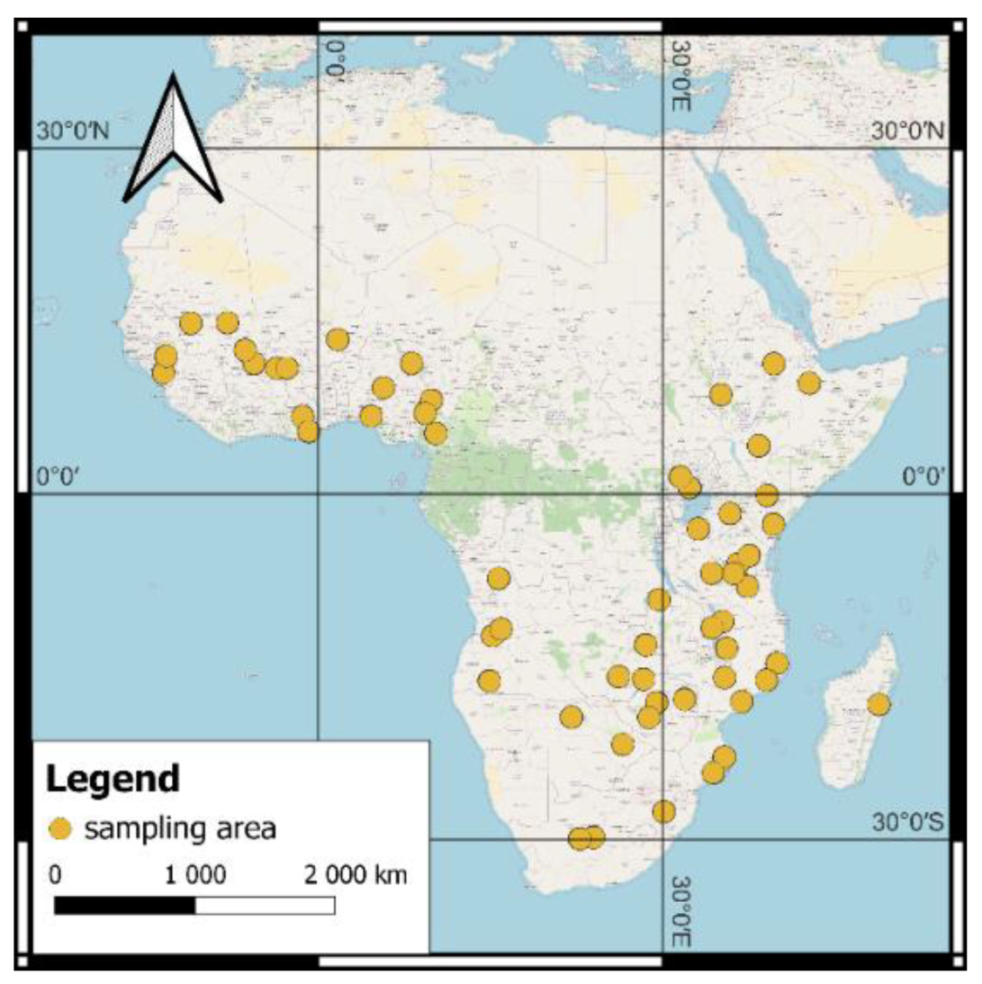
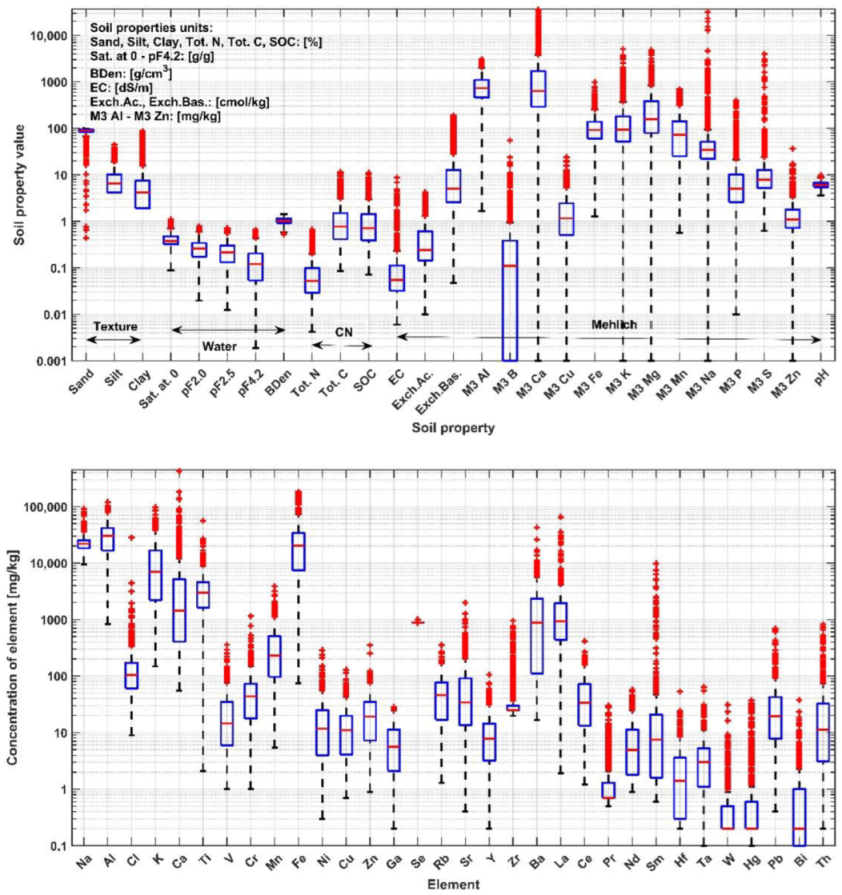
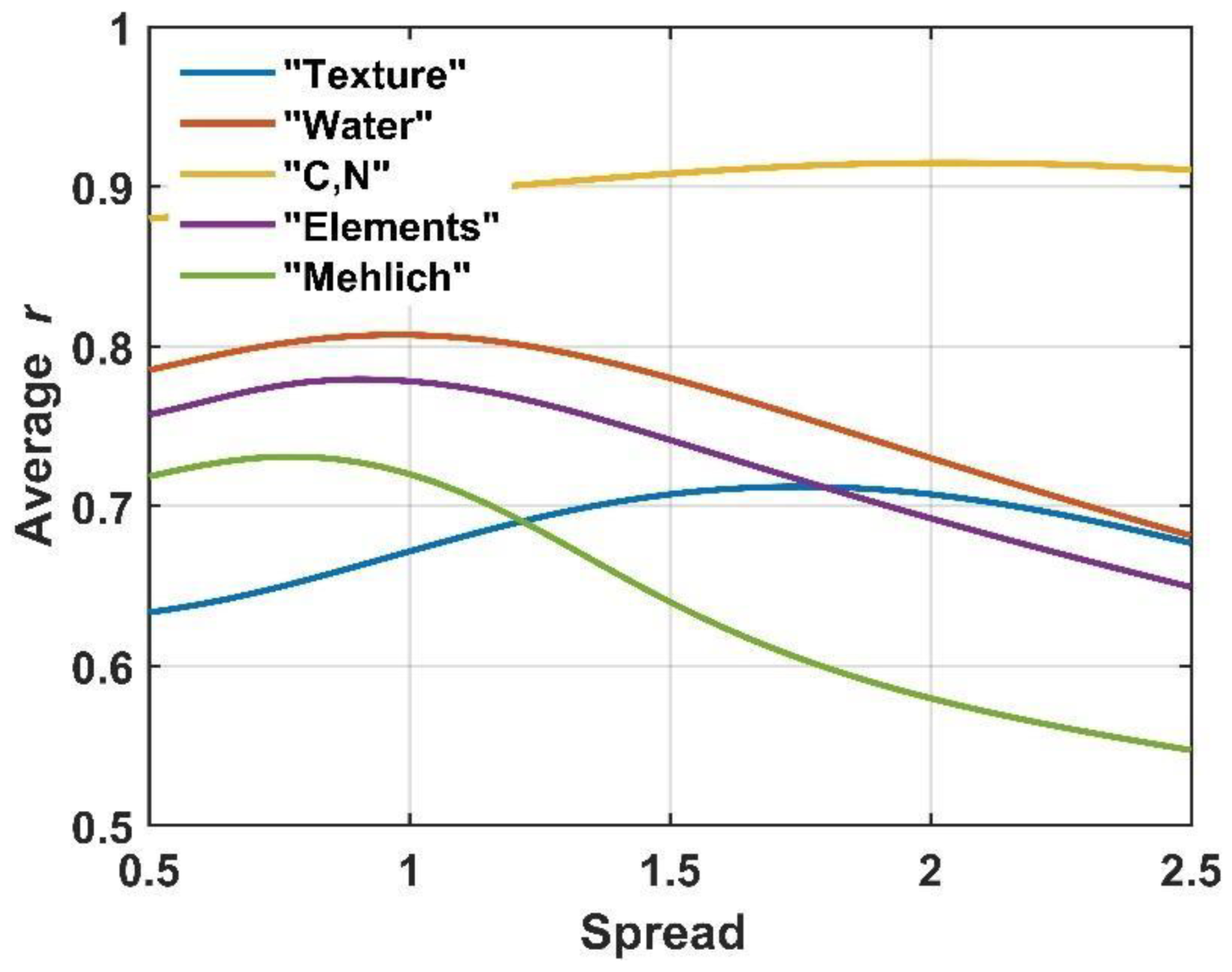
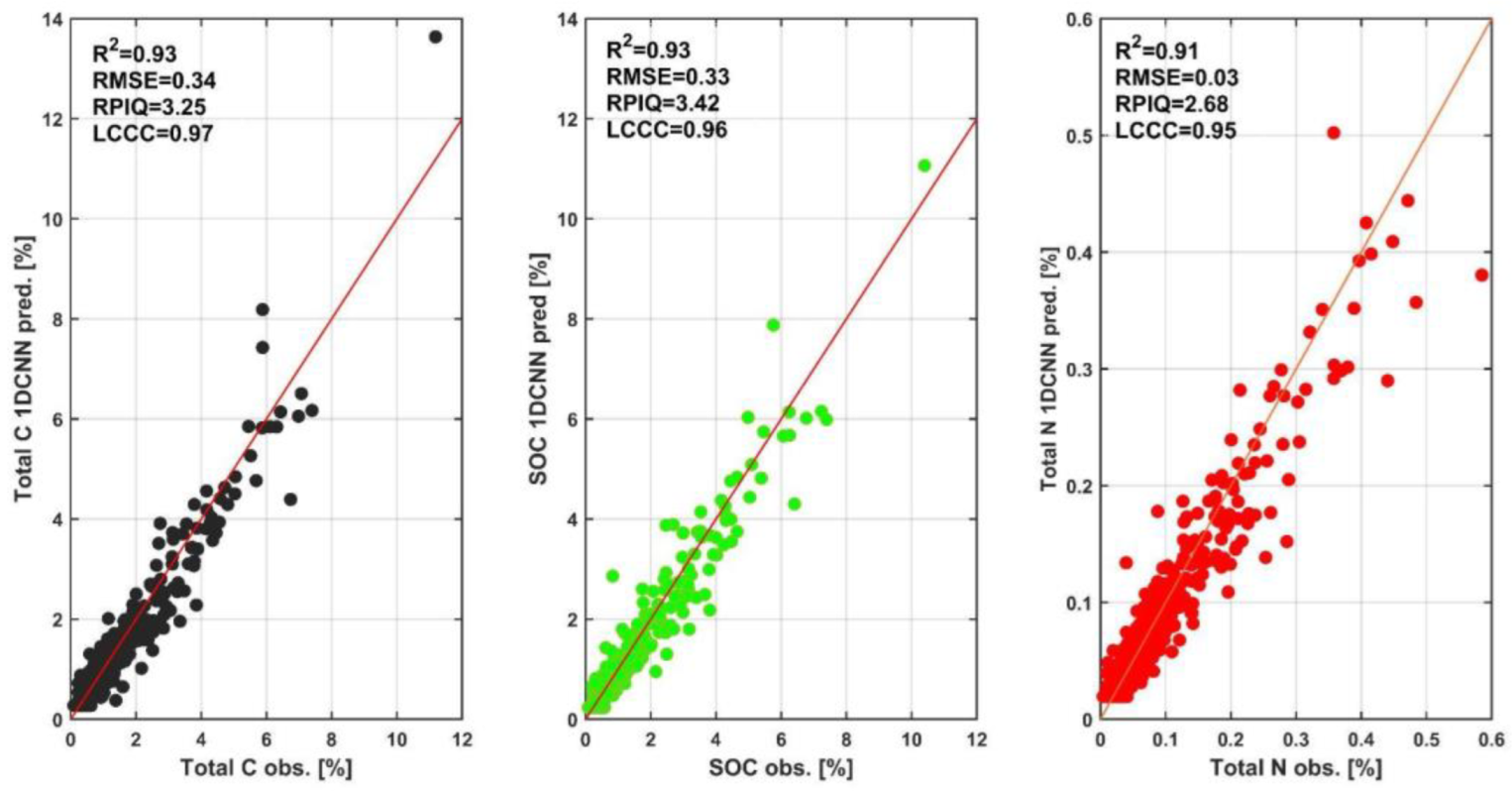



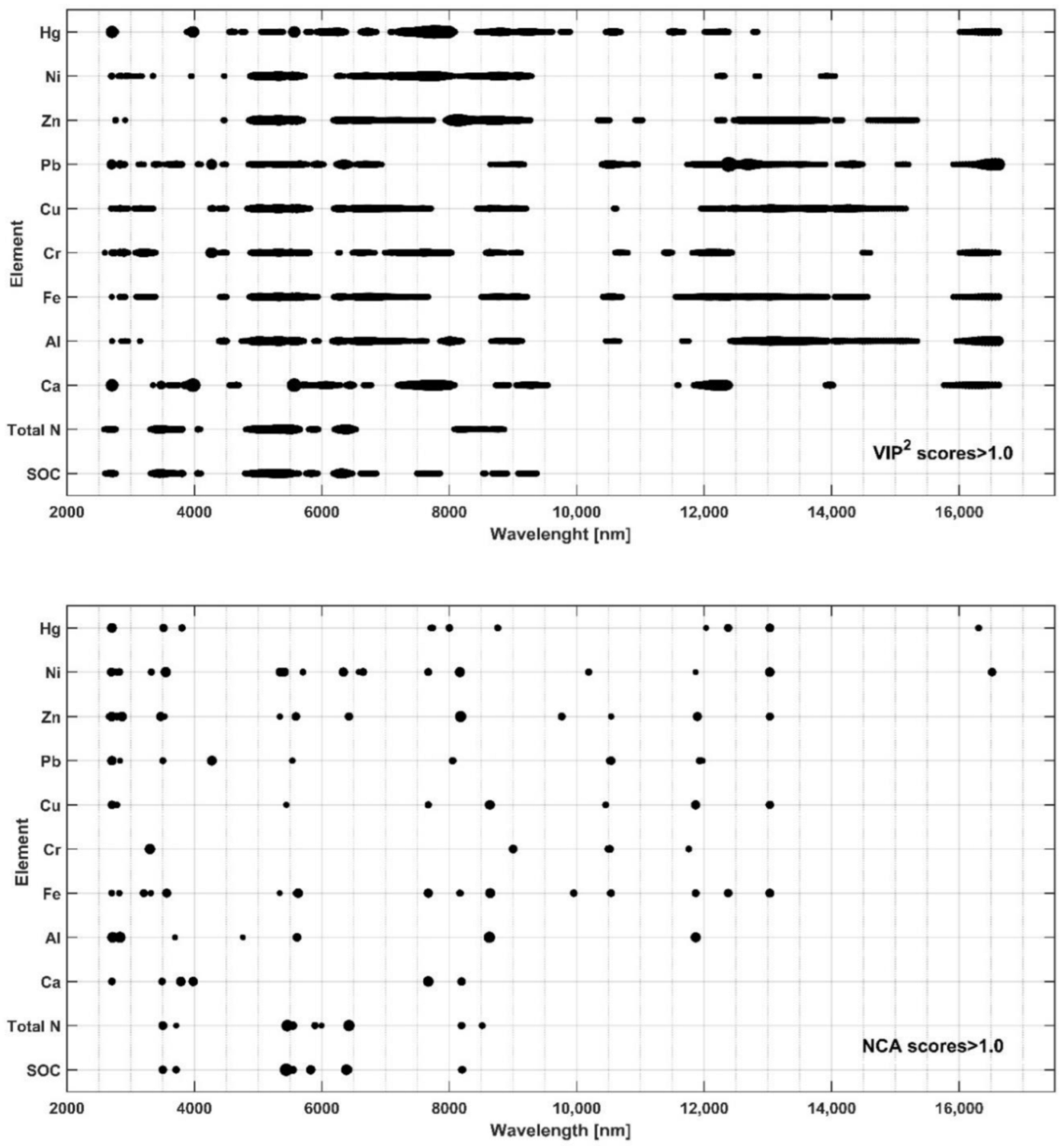
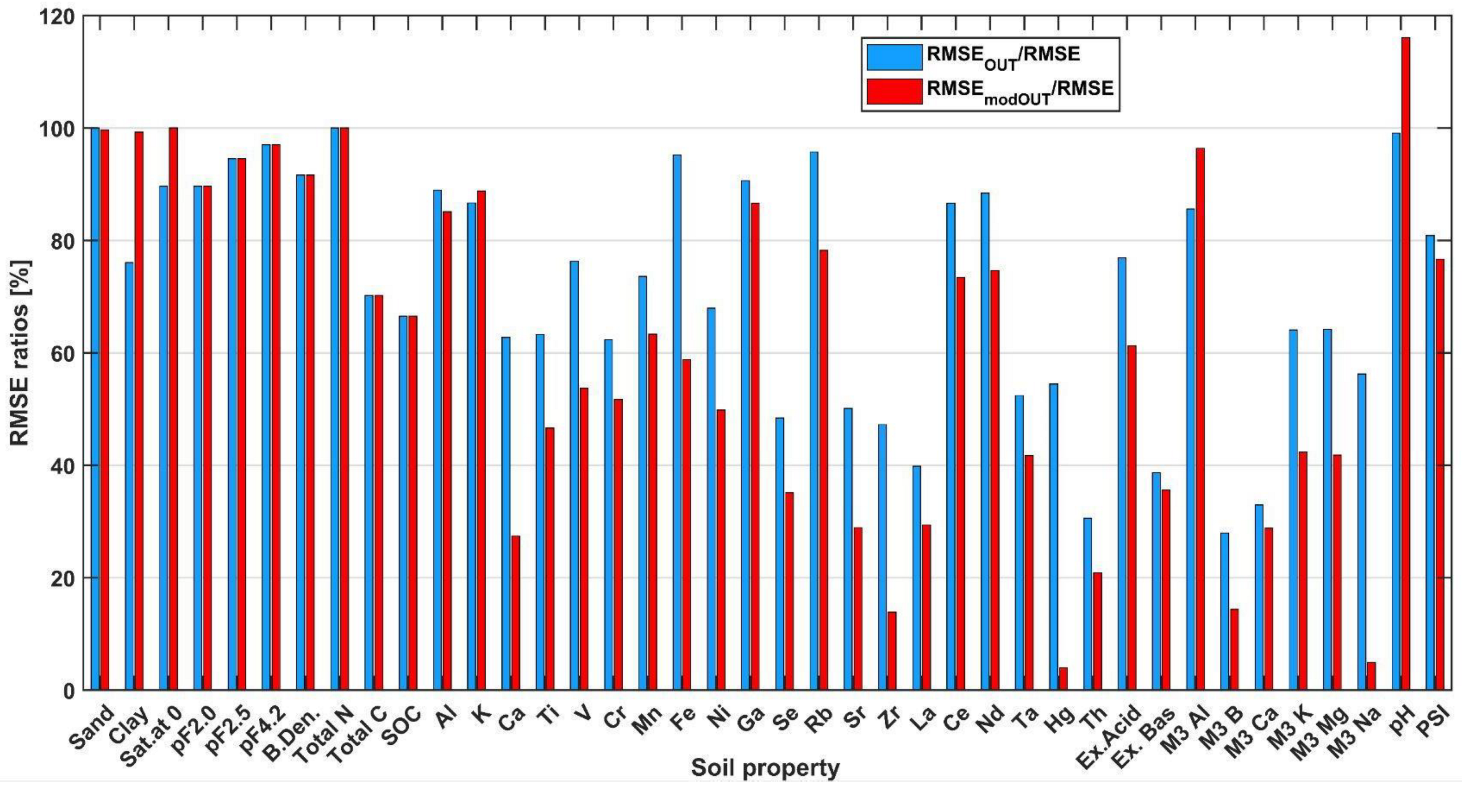
| Property | PLSR | 1DCNN | GRNN | |||||||||||||
|---|---|---|---|---|---|---|---|---|---|---|---|---|---|---|---|---|
| R2 | RMSE | RPIQ | LCCC | Sb | R2 | RMSE | RPIQ | LCCC | Sb | R2 | RMSE | RPIQ | LCCC | Sb | ||
| Sand | [%] | 0.62 | 8.83 | 1.08 | 0.79 | 0.05 | 0.60 | 9.02 | 1.05 | 0.73 | −0.02 | 0.54 | 9.65 | 0.98 | 0.72 | −0.01 |
| Silt | [%] | 0.54 | 4.04 | 1.41 | 0.73 | 0.00 | 0.37 | 4.71 | 1.21 | 0.59 | 0.31 | 0.32 | 4.90 | 1.16 | 0.56 | 0.03 |
| Clay | [%] | 0.64 | 5.72 | 0.93 | 0.80 | −0.04 | 0.64 | 5.74 | 0.93 | 0.77 | 0.28 | 0.66 | 5.54 | 0.97 | 0.79 | 0.03 |
| Property | PLSR | 1DCNN | GRNN | |||||||||||||
|---|---|---|---|---|---|---|---|---|---|---|---|---|---|---|---|---|
| R2 | RMSE | RPIQ | LCCC | Sb | R2 | RMSE | RPIQ | LCCC | Sb | R2 | RMSE | RPIQ | LCCC | Sb | ||
| Sat. at 0 | [g/g] | 0.61 | 0.09 | 1.64 | 0.77 | 0.04 | 0.61 | 0.09 | 1.66 | 0.77 | −0.05 | 0.70 | 0.08 | 1.89 | 0.82 | 0.07 |
| pF2.0 | [g/g] | 0.55 | 0.08 | 2.05 | 0.73 | 0.05 | 0.60 | 0.08 | 2.17 | 0.76 | 0.00 | 0.62 | 0.08 | 2.24 | 0.77 | 0.05 |
| pF2.5 | [g/g] | 0.56 | 0.08 | 2.20 | 0.74 | 0.05 | 0.62 | 0.07 | 2.38 | 0.77 | −0.01 | 0.62 | 0.07 | 2.38 | 0.77 | 0.05 |
| pF4.2 | [g/g] | 0.49 | 0.08 | 1.94 | 0.67 | 0.06 | 0.59 | 0.07 | 2.15 | 0.73 | 0.01 | 0.56 | 0.07 | 2.10 | 0.72 | 0.06 |
| B. Den. | [g/cm3] | 0.76 | 0.08 | 2.96 | 0.86 | 0.01 | 0.74 | 0.08 | 2.83 | 0.85 | 0.03 | 0.73 | 0.08 | 2.76 | 0.84 | 0.00 |
| Property | PLSR | 1DCNN | GRNN | |||||||||||||
|---|---|---|---|---|---|---|---|---|---|---|---|---|---|---|---|---|
| R2 | RMSE | RPIQ | LCCC | Sb | R2 | RMSE | RPIQ | LCCC | Sb | R2 | RMSE | RPIQ | LCCC | Sb | ||
| Total N | [%] | 0.84 | 0.03 | 2.03 | 0.91 | 0.01 | 0.91 | 0.03 | 2.68 | 0.95 | 0.00 | 0.80 | 0.04 | 1.85 | 0.88 | −0.01 |
| Total C | [%] | 0.92 | 0.38 | 2.95 | 0.96 | 0.00 | 0.93 | 0.34 | 3.25 | 0.97 | 0.05 | 0.87 | 0.47 | 2.37 | 0.93 | −0.01 |
| SOC | [%] | 0.91 | 0.37 | 3.02 | 0.96 | 0.00 | 0.93 | 0.33 | 3.42 | 0.96 | 0.05 | 0.86 | 0.47 | 2.39 | 0.92 | −0.02 |
| Property | PLSR | 1DCNN | GRNN | |||||||||||||
|---|---|---|---|---|---|---|---|---|---|---|---|---|---|---|---|---|
| R2 | RMSE | RPIQ | LCCC | Sb | R2 | RMSE | RPIQ | LCCC | Sb | R2 | RMSE | RPIQ | LCCC | Sb | ||
| Na | [mg/kg] | 0.46 | 6452.1 | 1.09 | 0.64 | 0.04 | 0.36 | 7029.8 | 1.00 | 0.54 | 0.13 | 0.44 | 6553.6 | 1.07 | 0.62 | −0.01 |
| Al | [mg/kg] | 0.77 | 8714.3 | 2.87 | 0.87 | −0.02 | 0.76 | 8854.0 | 2.83 | 0.86 | −0.01 | 0.79 | 8377.4 | 2.98 | 0.88 | 0.00 |
| Cl | [mg/kg] | 0.00 | 1592.5 | 0.07 | 0.43 | −0.79 | 0.00 | 1199.5 | 0.09 | 0.06 | 0.44 | 0.30 | 1013.5 | 0.11 | 0.44 | −0.37 |
| K | [mg/kg] | 0.83 | 4990.3 | 2.89 | 0.91 | −0.03 | 0.79 | 5437.6 | 2.66 | 0.89 | 0.07 | 0.72 | 6299.1 | 2.29 | 0.84 | −0.06 |
| Ca | [mg/kg] | 0.95 | 5148 | 0.93 | 0.98 | −0.05 | 0.61 | 14,979 | 0.32 | 0.75 | −0.36 | 0.94 | 5767 | 0.83 | 0.97 | 0.04 |
| Ti | [mg/kg] | 0.41 | 3203.3 | 0.93 | 0.69 | −0.05 | 0.36 | 3342.7 | 0.89 | 0.59 | 0.15 | 0.67 | 2422.0 | 1.22 | 0.81 | −0.04 |
| V | [mg/kg] | 0.51 | 27.98 | 1.04 | 0.72 | −0.10 | 0.49 | 28.59 | 1.01 | 0.64 | −0.02 | 0.63 | 24.12 | 1.20 | 0.78 | −0.08 |
| Cr | [mg/kg] | 0.40 | 64.72 | 0.85 | 0.60 | −0.10 | 0.30 | 70.07 | 0.79 | 0.47 | 0.05 | 0.68 | 47.08 | 1.17 | 0.81 | −0.02 |
| Mn | [mg/kg] | 0.44 | 336.76 | 1.21 | 0.70 | −0.02 | 0.54 | 304.55 | 1.34 | 0.71 | 0.07 | 0.62 | 278.77 | 1.46 | 0.76 | −0.03 |
| Fe | [mg/kg] | 0.79 | 12,398 | 2.13 | 0.89 | −0.01 | 0.79 | 12,624 | 2.10 | 0.86 | 0.07 | 0.86 | 10,274 | 2.57 | 0.92 | −0.01 |
| Ni | [mg/kg] | 0.47 | 19.70 | 1.05 | 0.70 | −0.11 | 0.54 | 18.30 | 1.13 | 0.71 | −0.06 | 0.66 | 15.75 | 1.31 | 0.79 | −0.01 |
| Cu | [mg/kg] | 0.55 | 10.04 | 1.56 | 0.72 | 0.01 | 0.52 | 10.38 | 1.50 | 0.72 | −0.01 | 0.59 | 9.64 | 1.62 | 0.74 | 0.00 |
| Zn | [mg/kg] | 0.41 | 21.48 | 1.27 | 0.63 | −0.02 | 0.37 | 22.13 | 1.24 | 0.64 | −0.09 | 0.46 | 20.57 | 1.33 | 0.66 | −0.01 |
| Ga | [mg/kg] | 0.68 | 3.36 | 2.73 | 0.82 | −0.04 | 0.63 | 3.59 | 2.56 | 0.79 | −0.12 | 0.73 | 3.07 | 2.99 | 0.84 | 0.00 |
| Se | [mg/kg] | 0.71 | 9.00 | 0.36 | 0.82 | 0.24 | 0.59 | 10.75 | 0.30 | 0.72 | −0.96 | 0.81 | 7.37 | 0.43 | 0.89 | 0.11 |
| Rb | [mg/kg] | 0.71 | 25.31 | 2.38 | 0.84 | −0.02 | 0.65 | 28.00 | 2.15 | 0.78 | 0.11 | 0.72 | 25.07 | 2.40 | 0.83 | −0.03 |
| Sr | [mg/kg] | 0.42 | 118.85 | 0.65 | 0.68 | 0.01 | 0.63 | 94.37 | 0.82 | 0.76 | 0.10 | 0.49 | 111.22 | 0.69 | 0.63 | 0.02 |
| Y | [mg/kg] | 0.42 | 8.69 | 1.30 | 0.63 | −0.05 | 0.40 | 8.83 | 1.27 | 0.59 | −0.05 | 0.48 | 8.23 | 1.37 | 0.65 | −0.02 |
| Zr | [mg/kg] | 0.47 | 83.82 | 0.06 | 0.71 | −1.86 | 0.58 | 74.20 | 0.07 | 0.69 | 0.93 | 0.77 | 55.06 | 0.09 | 0.86 | 0.22 |
| Ba | [mg/kg] | 0.39 | 2331.2 | 0.96 | 0.64 | −0.05 | 0.26 | 2560.7 | 0.87 | 0.42 | 0.03 | 0.44 | 2223.5 | 1.00 | 0.62 | 0.02 |
| La | [mg/kg] | 0.48 | 3190.5 | 0.47 | 0.62 | 0.12 | 0.39 | 3447.5 | 0.44 | 0.52 | 0.34 | 0.82 | 1874.5 | 0.80 | 0.89 | 0.06 |
| Ce | [mg/kg] | 0.36 | 38.65 | 1.51 | 0.67 | −0.04 | 0.41 | 37.10 | 1.57 | 0.67 | 0.05 | 0.56 | 31.97 | 1.83 | 0.75 | −0.06 |
| Pr | [mg/kg] | 0.26 | 2.92 | 0.21 | 0.42 | 0.44 | 0.15 | 3.13 | 0.19 | 0.22 | 0.25 | 0.33 | 2.78 | 0.22 | 0.47 | 0.60 |
| Nd | [mg/kg] | 0.42 | 6.69 | 1.40 | 0.68 | −0.04 | 0.41 | 6.73 | 1.40 | 0.61 | −0.05 | 0.62 | 5.42 | 1.73 | 0.78 | −0.06 |
| Sm | [mg/kg] | 0.34 | 600.16 | 0.03 | 0.46 | 1.75 | 0.17 | 671.35 | 0.03 | 0.24 | 4.85 | 0.58 | 477.83 | 0.04 | 0.72 | 0.65 |
| Hf | [mg/kg] | 0.14 | 4.04 | 0.82 | 0.54 | −0.16 | 0.05 | 4.26 | 0.77 | 0.29 | 0.27 | 0.40 | 3.39 | 0.97 | 0.59 | −0.08 |
| Ta | [mg/kg] | 0.54 | 4.50 | 0.91 | 0.70 | 0.02 | 0.37 | 5.31 | 0.77 | 0.48 | 0.03 | 0.73 | 3.43 | 1.19 | 0.84 | 0.01 |
| W | [mg/kg] | 0.37 | 1.78 | 0.17 | 0.57 | 0.07 | 0.18 | 2.03 | 0.15 | 0.31 | 0.43 | 0.41 | 1.72 | 0.17 | 0.64 | −0.11 |
| Hg | [mg/kg] | 0.52 | 3.36 | 0.12 | 0.76 | −1.12 | 0.46 | 3.57 | 0.11 | 0.68 | −2.07 | 0.65 | 2.85 | 0.14 | 0.85 | −0.78 |
| Pb | [mg/kg] | 0.34 | 54.29 | 0.64 | 0.59 | −0.02 | 0.39 | 52.50 | 0.66 | 0.53 | 0.22 | 0.70 | 36.57 | 0.94 | 0.81 | 0.00 |
| Bi | [mg/kg] | 0.02 | 3.02 | 0.30 | 0.62 | −0.55 | 0.35 | 2.47 | 0.36 | 0.66 | 0.19 | 0.56 | 2.01 | 0.45 | 0.76 | −0.25 |
| Th | [mg/kg] | 0.65 | 54.15 | 0.54 | 0.77 | 0.04 | 0.63 | 56.12 | 0.52 | 0.71 | 0.39 | 0.77 | 43.79 | 0.67 | 0.86 | 0.06 |
| Property | PLSR | 1DCNN | GRNN | |||||||||||||
|---|---|---|---|---|---|---|---|---|---|---|---|---|---|---|---|---|
| R2 | RMSE | RPIQ | LCCC | Sb | R2 | RMSE | RPIQ | LCCC | Sb | R2 | RMSE | RPIQ | LCCC | Sb | ||
| EC | [dS/m] | 0.19 | 0.28 | 0.29 | 0.47 | −0.05 | 0.38 | 0.25 | 0.34 | 0.64 | −0.18 | 0.31 | 0.26 | 0.32 | 0.50 | 0.16 |
| Ex. Ac. | [cmol/kg] | 0.40 | 0.45 | 1.15 | 0.58 | 0.02 | 0.55 | 0.39 | 1.33 | 0.73 | 0.02 | 0.33 | 0.48 | 1.09 | 0.57 | 0.07 |
| Ex. Bas. | [cmol/kg] | 0.82 | 9.99 | 1.01 | 0.91 | 0.01 | 0.88 | 8.05 | 1.26 | 0.94 | 0.05 | 0.90 | 7.50 | 1.35 | 0.95 | 0.02 |
| M3 Al | [mg/kg] | 0.84 | 192.32 | 3.43 | 0.92 | 0.01 | 0.86 | 181.99 | 3.63 | 0.92 | 0.01 | 0.85 | 189.46 | 3.48 | 0.92 | 0.00 |
| M3 B | [mg/kg] | 0.39 | 1.33 | 0.26 | 0.55 | 0.11 | 0.70 | 0.93 | 0.37 | 0.80 | 0.23 | 0.37 | 1.35 | 0.26 | 0.51 | 0.21 |
| M3 Ca | [mg/kg] | 0.82 | 1752.3 | 0.76 | 0.90 | 0.02 | 0.82 | 1741.9 | 0.76 | 0.90 | 0.04 | 0.89 | 1394.7 | 0.96 | 0.94 | 0.02 |
| M3Cu | [mg/kg] | 0.19 | 1.90 | 0.98 | 0.38 | −0.03 | 0.33 | 1.73 | 1.07 | 0.53 | −0.04 | 0.50 | 1.49 | 1.25 | 0.70 | −0.04 |
| M3 Fe | [mg/kg] | 0.42 | 70.28 | 1.26 | 0.57 | 0.06 | 0.49 | 65.81 | 1.34 | 0.63 | 0.04 | 0.39 | 72.11 | 1.22 | 0.56 | 0.07 |
| M3 K | [mg/kg] | 0.18 | 227.55 | 0.57 | 0.55 | −0.13 | 0.40 | 194.01 | 0.66 | 0.56 | 0.18 | 0.65 | 147.94 | 0.87 | 0.80 | −0.04 |
| M3 Mg | [mg/kg] | 0.68 | 234.54 | 1.28 | 0.82 | −0.03 | 0.74 | 209.04 | 1.44 | 0.86 | 0.02 | 0.68 | 232.25 | 1.29 | 0.81 | 0.01 |
| M3 Mn | [mg/kg] | 0.47 | 75.63 | 1.54 | 0.64 | 0.02 | 0.58 | 67.78 | 1.72 | 0.73 | 0.04 | 0.51 | 73.30 | 1.59 | 0.72 | −0.04 |
| M3 Na | [mg/kg] | 0.00 | 1003.1 | 0.03 | 0.32 | 0.88 | 0.11 | 942.55 | 0.03 | 0.47 | 1.14 | 0.89 | 325.35 | 0.09 | 0.83 | 0.85 |
| M3 P | [mg/kg] | 0.02 | 28.66 | 0.25 | 0.15 | −0.15 | 0.25 | 25.06 | 0.28 | 0.39 | 0.35 | 0.19 | 25.99 | 0.27 | 0.38 | 0.14 |
| M3 S | [mg/kg] | 0.12 | 199.34 | 0.04 | 0.20 | 1.06 | 0.28 | 180.35 | 0.05 | 0.50 | 1.23 | 0.49 | 151.66 | 0.05 | 0.44 | 1.62 |
| M3 Zn | [mg/kg] | 0.13 | 1.50 | 0.64 | 0.30 | −0.15 | 0.22 | 1.42 | 0.68 | 0.31 | 0.08 | 0.11 | 1.52 | 0.64 | 0.34 | −0.02 |
| pH | 0.81 | 0.48 | 2.80 | 0.90 | −0.01 | 0.84 | 0.43 | 3.07 | 0.91 | −0.03 | 0.77 | 0.52 | 2.56 | 0.87 | 0.00 | |
| PSI | 0.75 | 45.09 | 1.96 | 0.85 | 0.02 | 0.72 | 47.35 | 1.86 | 0.83 | 0.14 | 0.78 | 41.79 | 2.11 | 0.88 | 0.04 | |
| Rank | PLSR | 1DCNN | GRNN | |||
|---|---|---|---|---|---|---|
| Property | Tindex | Property | Tindex | Property | Tindex | |
| 1 | M3 Al | 0.839 | SOC | 0.853 | M3 Al | 0.843 |
| 2 | SOC | 0.833 | M3 Al | 0.847 | Al | 0.800 |
| 3 | Total C | 0.831 | Total C | 0.846 | Ga | 0.780 |
| 4 | K | 0.809 | pH | 0.824 | Fe | 0.777 |
| 5 | pH | 0.796 | Total N | 0.808 | Total C | 0.776 |
| 6 | B. Den. | 0.790 | Al | 0.782 | SOC | 0.776 |
| 7 | Al | 0.789 | K | 0.777 | B. Den. | 0.762 |
| 8 | Ga | 0.748 | B. Den. | 0.772 | pH | 0.760 |
| 9 | Total N | 0.737 | Fe | 0.725 | Rb | 0.733 |
| 10 | Fe | 0.736 | Ga | 0.718 | PSI | 0.729 |
| 11 | Rb | 0.732 | pF2.5 | 0.692 | K | 0.728 |
| 12 | PSI | 0.704 | PSI | 0.683 | Total N | 0.713 |
| 13 | Ca | 0.666 | Rb | 0.680 | pF2.5 | 0.690 |
| 14 | pF2.5 | 0.652 | Ex. Bas. | 0.678 | Ex. Bas. | 0.689 |
| 15 | Ex. Bas. | 0.646 | pF2.0 | 0.667 | Sat. at 0 | 0.682 |
| 16 | pF2.0 | 0.638 | M3 Mg | 0.660 | pF2.0 | 0.680 |
| 17 | Sat. at 0 | 0.630 | pF4.2 | 0.656 | M3 Ca | 0.655 |
| 18 | M3 Mg | 0.629 | Sat. at 0 | 0.635 | Nd | 0.646 |
| 19 | M3 Ca | 0.626 | M3 Ca | 0.626 | Ca | 0.646 |
| 20 | Cu | 0.600 | M3 Mn | 0.619 | pF4.2 | 0.642 |
| 21 | pF4.2 | 0.598 | Cu | 0.589 | Ta | 0.637 |
| 22 | Sand | 0.593 | Ex. Ac. | 0.583 | Ce | 0.630 |
| 23 | Clay | 0.592 | Sand | 0.578 | M3 Mg | 0.628 |
| 24 | Silt | 0.588 | Mn | 0.576 | Ni | 0.623 |
| 25 | Se | 0.562 | Clay | 0.575 | Ti | 0.621 |
| 26 | Th | 0.559 | Sr | 0.569 | La | 0.621 |
| 27 | M3 Mn | 0.557 | Ni | 0.567 | Cr | 0.620 |
| 28 | V | 0.554 | M3 B | 0.557 | Cu | 0.619 |
| 29 | Nd | 0.546 | Ce | 0.550 | Mn | 0.618 |
| 30 | Ta | 0.545 | M3 Fe | 0.547 | V | 0.608 |
Publisher’s Note: MDPI stays neutral with regard to jurisdictional claims in published maps and institutional affiliations. |
© 2022 by the authors. Licensee MDPI, Basel, Switzerland. This article is an open access article distributed under the terms and conditions of the Creative Commons Attribution (CC BY) license (https://creativecommons.org/licenses/by/4.0/).
Share and Cite
Gruszczyński, S.; Gruszczyński, W. Assessing the Information Potential of MIR Spectral Signatures for Prediction of Multiple Soil Properties Based on Data from the AfSIS Phase I Project. Int. J. Environ. Res. Public Health 2022, 19, 15210. https://doi.org/10.3390/ijerph192215210
Gruszczyński S, Gruszczyński W. Assessing the Information Potential of MIR Spectral Signatures for Prediction of Multiple Soil Properties Based on Data from the AfSIS Phase I Project. International Journal of Environmental Research and Public Health. 2022; 19(22):15210. https://doi.org/10.3390/ijerph192215210
Chicago/Turabian StyleGruszczyński, Stanisław, and Wojciech Gruszczyński. 2022. "Assessing the Information Potential of MIR Spectral Signatures for Prediction of Multiple Soil Properties Based on Data from the AfSIS Phase I Project" International Journal of Environmental Research and Public Health 19, no. 22: 15210. https://doi.org/10.3390/ijerph192215210






